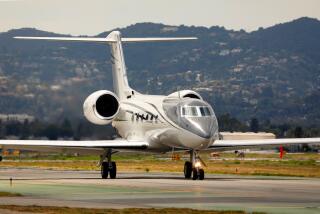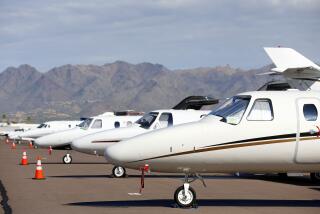Danger Hits Home for Corporate Jet Users
- Share via
When pro golfer Payne Stewart’s Learjet crashed into a field in rural South Dakota, the impact rattled corporate aircraft users everywhere, especially in the Southland, home to three airports that lead the nation in business plane traffic.
Dick Engel, chief executive of Costa Mesa-based Powerplant Maintenance Specialists Inc., used to own a twin-engine Learjet 35--the same kind of plane that carried Stewart.
“His was built in 1976, mine was built in 1975,” Engel said. “I woke up last night in a nightmare, just thinking, ‘What if?’ ”
Jets have become increasingly common corporate accessories in the late ‘90s, as companies have expanded into faraway regions and executives have looked for ways to save time.
About 9,000 turbine-powered business aircraft are now operated in the U.S., up from less than 7,000 in 1993, the National Business Aviation Assn. said.
The Southland is home to three of the top five airports nationally, with the most single-engine and business aircraft traffic, Federal Aviation Administration records show. Van Nuys Airport ranks first, John Wayne Airport is second and Long Beach Airport is fourth.
Business jets took off or landed an average of 40 times a day at John Wayne Airport last year, airport officials said. Dozens of companies headquartered here own or lease jets, including Taco Bell Corp., Viacom Inc. and Universal Studios Inc., said Dan Burkhardt, the NBAA’s western regional representative.
Since Monday’s crash, the association has been deluged with questions from members.
“They’re asking, ‘Is there anything we can do?’ ” said Bob Blouin, the group’s senior vice president of operations. “Is there something we can improve? Is there something we can check? The pressurization system, the valves?”
Rick Sharlow pilots three flights a week out of John Wayne Airport, shuttling executives to locations in Nevada and California. Because preliminary reports tied the crash to a loss of cabin pressure, attention to maintenance procedures has become even more meticulous than usual, he said.
“Everybody is just double-checking,” Sharlow said. “The attention to preflight is intense.”
The safety record of small, privately owned planes has improved markedly in the last five years, but it still does not equal that of commercial jets.
Last year, there were just over seven accidents per 100,000 flight hours for smaller aircraft, compared with about one accident per 380,000 flight hours for commercial jets, National Transportation Safety Board data show.
Robert E. Gray, CEO of St. John Knits Inc., said his company uses its Falcon 50 aircraft about 300 hours a year and has had no close calls or incidents that frightened him. Gray remained confident after Monday’s crash, saying his plane is operated by pilots who are longtime employees of the Irvine-based company.
Engel, a mechanical engineer who worked for Lear in the mid-1960s, bought his Learjet 35 in 1990. Passengers often complained about cool cabin temperatures, even when pilots cranked up the heat, he said. A mechanic tore the plane apart and made a couple of disturbing discoveries.
The plane’s reheat valve, which controls the cabin temperature, was installed backward. And the valve that controlled access to the emergency oxygen supply was corroded shut. Engel sold the Lear in 1995, upgrading to a larger plane. He is planning to buy another jet now, but Monday’s accident left him apprehensive.
“[The crash] has scared the hell out of me,” he said. “I’m not sure I want to fly around in a jet that’s over 20 years old, let alone own one.”
*
Times staff writer Leslie Earnest contributed to this story.
More to Read
Inside the business of entertainment
The Wide Shot brings you news, analysis and insights on everything from streaming wars to production — and what it all means for the future.
You may occasionally receive promotional content from the Los Angeles Times.









